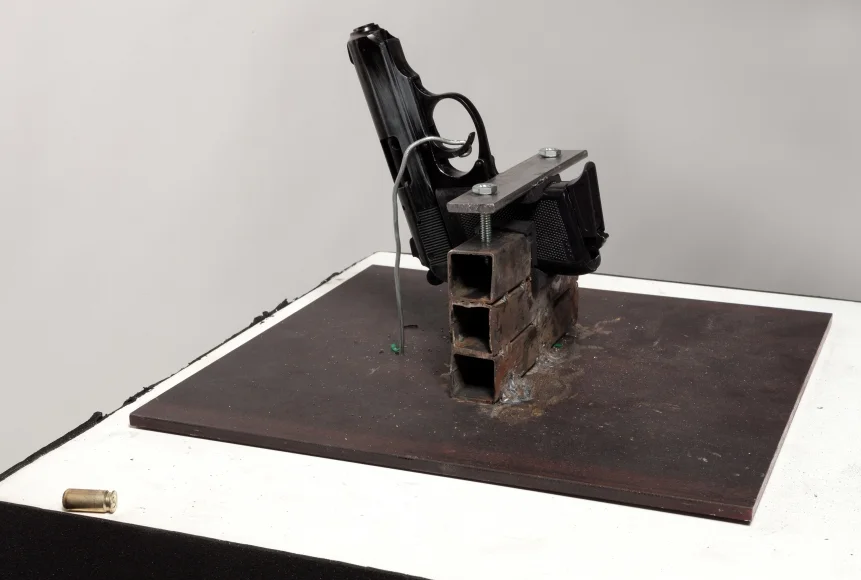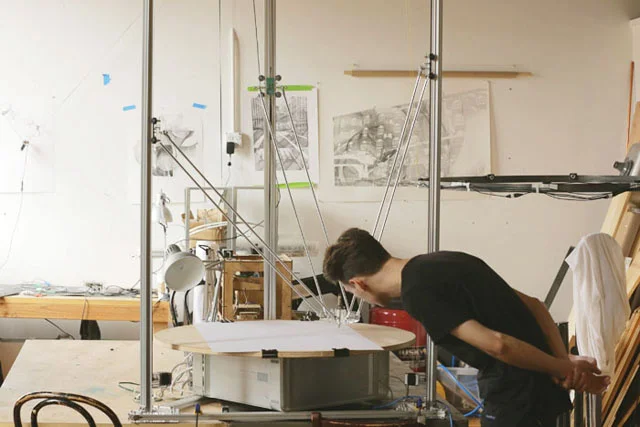McLove
Pascal Dombis, a French digital artist, created his work McLove around 2004 until 2007. McLove explores two important global symbols: the McDonald’s arch and the love symbol or heart shape. Both of these symbols have soft curves with no hard lines or angles. They are also symmetric shapes that have similarities in form to one another. In his work McLove, Dombis uses these symbols together by superimposing them and transforming them. He almost morphs one into the other and back throughout the piece. The video work incorporates photography found on Google Images that relate to McDonald’s corporate advertising as well as the anti-McDonald’s movement.
This video piece starts out by introducing the symbols and converting them into unique shapes and patterns. It then introduces the imagery as an overlay. Throughout the piece, the viewer can see various levels of clarity of the imagery based on the thickness of the overlaid shapes and patterns. Additionally, various point in the piece flash the images on their own to expose some of the works concepts more obviously. At the conclusion of this video, the audience members may have various impressions based on the imagery that stood out to them most clearly. There are images relating to McDonald’s founders, corporate sponsorships, Ronald McDonald, and even the happy meal toys being used as sex toys. Overall, there is a very high sense of both for and against McDonald’s that can be seen in this work, and the interpretation is up to the viewer.
Art Plural Gallery says,
“Over his more than twenty-year career, Dombis has been using computers and algorithms to generate elaborate repetitions of simple processes, which computationally reproduce geometric or typographical signs. These de-structuring structures and irrational environments disturb, engage and inspire the viewer, posing fascinating paradoxes between the mechanical control and chaotic randomness that produce them” Art Plural Gallery. (2016) Pascal Dombis. http://www.artpluralgallery.com/artists/38-pascal-dombis/overview/
Image from Pascal Dombis.
Pascal Dombis explains that,
“The origin of this work lies in the play of stretching a line like when you use a bow and an arrow > when you stretch it, you get a curve, which is similar to one of the 2 arch of the McDonalds logo. All my work is about the multiplicities of meaning and how to use the digital media to increase these multiplicities thru excessive computational processes. So I have developed several work where geometric elements tells several stories beyond their formal characteristic and this McLove pieces goes in that series. I have developed several simple graphic algorithm that stretch the lines and produce sometime the McDonalds logo, as well as the Love sign, and also a wide range of decorative pattern that could relate to the historical Islamic art in Andalusia or Iran. Also baroque pattern …” Dombis, P. (2016, May 23). Email Interview.
Image from Pascal Dombis.
The uses of the McDonald’s arch and the love symbol or heart were selected very purposefully by Dombis and are what give this work a very rich critical content. The McDonald’s logo was chosen because it is a global symbol that represents capitalism and globalization. On the other hand, the heart is an old symbol that has a lot of different cultural and religious meanings that associate back to love and union. Dombis chose the McDonald’s arch over other important brand logos with similar meanings such as Coca-Cola and Starbucks.
Dombis explains that he did this because
“they are too complicated to be described in simple algorithmic term and also I do not think that a google search will produce as a wide range of images as the McDonalds one” Dombis, P. (2016, May 23). Email Interview.
Image from Pascal Dombis.
Additionally, in order to understand the concepts of this work it is important to understand the anti-McDonald’s movement. In France in 1999 the French anti-globalization and anti-McDo movement began when José Bové dismantled a McDonalds being built in Millau with the second largest farmers’ union in France. The movement was instigated when the World Trade Organization supported the United States in exporting hormone induced beef to Europe. The anti-McDo movement is still popular in France and citizens continue to oppose political consumerism and globalization throughout the country. This work specifically addresses these issues and what the McDonald’s logo represents in today’s society.
The constant flickering of images related to pro-McDo and anti-McDo movements elaborate on the cultural importance of this movement, specifically in France. By using such a recognizable brand for this work, Dombis is really forcing the audience to look deeper into the meanings and importance of globalization. By displaying the pros and cons equally, by using pro and anti imagery, it forces a conversation and curiosity about the anti-McDo movement to the larger audience outside of France.
Pascal Dombis explains his strategy here:
“I am using Google Image as a process tool for years and I found out interesting that when you google “McDonalds” you get roughly 2 sets of images : one is the McDo corporate marketing material as you can expect. And the other one is the anti-McDo ones that takes McDo as a symbol of Junk food, globalization and US imperialism. Images that range from jokes to activism. And many of these images are not “nice” and confront really well – I think – with the supposedly nice looking aspect the curve play.The way I use those 2 image sets was to create a flickering, alternative one image from each sets” Dombis, P. (2016, May 23). Email Interview.
Overall, this work deeply explores the relationship consumerism and globalization have on society by using a compare and contrast methodology. Dombis compares the pro-McDo and anti-McDo movements as well as the juxtaposition of the McDonald’s arch and the love symbol or heart to create unique shapes and patterns.
Image from Pascal Dombis.
Eurasia is another digital artwork created by Pascal Dombis that uses similar techniques, such as comparisons, algorithms, and Google Images. Eurasia is a digital collage made up of Google image search results to the words red, blue, black, and white on various countries Google pages. Specifically, Dombis compares search results from the Western world (.com, .de, .fr, .it) and the Eastern world (.cn, .kr, .jp). Using a random algorithm, the Google image search results are them connected in a structure to combine both sets of results as two halves of various works. The two halves approach emphasizes the distinct differences of the eastern and western worlds. This form of comparison is different than McLove. In McLove, Dombis compares pro and anti-McDo imagery by alternating the imagery flashing throughout the video. However, both of these works do play with comparison and use algorithms with Google image search to accomplish their goals. Like some of the variations of McLove, such as Love Grid and Mc, Eurasia is also primarily shown on lenticular panels, which fits Dombiss aesthetic and gives the audience a different point of view.
Dombis explains the concepts of Eurasia here:
“I like the fact that color perception are deeply related to the culture and to the language. For the Eurasia series, I have gather the google images in 2 sets of languages : the western ones and the Asian ones. And I’m working on the fact that color have somehow an opposite symbolic perception in the West and in the East (Asia). For example, in the west, black is the death color while it is the white in Asia, especially japan. Red in the West is associated with passion, sex and violence. While it is a plain happiness color in China. So I play with these symbolic opposition, but since I use Google which is a global tool, this cultural opposition tend to vanish” Dombis, P. (2016, May 23). Email Interview.
Image from Molleindustria.
The McDonald’s Video Game was created by Paolo Pedercini to expose the inner workings of the fast food industry. The game puts the player in the role of the CEO of the McDonald’s corporation and asks them to make strategic decisions related to the farm, slaughterhouse, restaurant, and corporate headquarters. However, the only way to win the game is to cut corners and use unethical business practices. This piece is an interesting comparison to Pascal Dombis’ McLove. McLove has cultural significance by exposing the pro and anti-McDo movement, but never actually expressed the artists true feelings about the industry. Instead it is more of a social commentary on the globalization and consumerism aspects of McDonald’s as a global symbol. On the other hand, Pedercini’s McDonald’s Video Game explores the actual inter workings of the fast food industry and makes a clear statement against the unethical business practices, by exposing the players to the realities of the industry.
McLove, Video Installation, 2006
Love Grid II, Lenticular mounted on florescent light box, 2005
Love Grid, Lenticular mounted on Plexiglass, 2006
Mc, Lenticular mounted on Plexiglass, 2006










